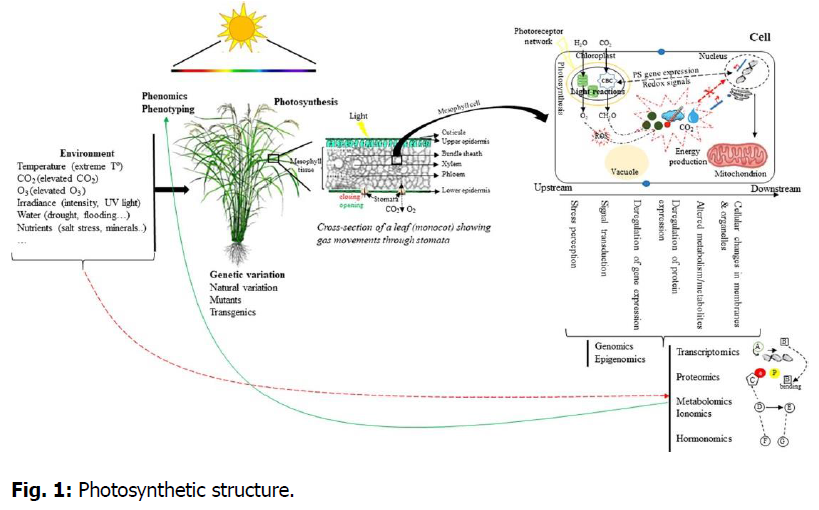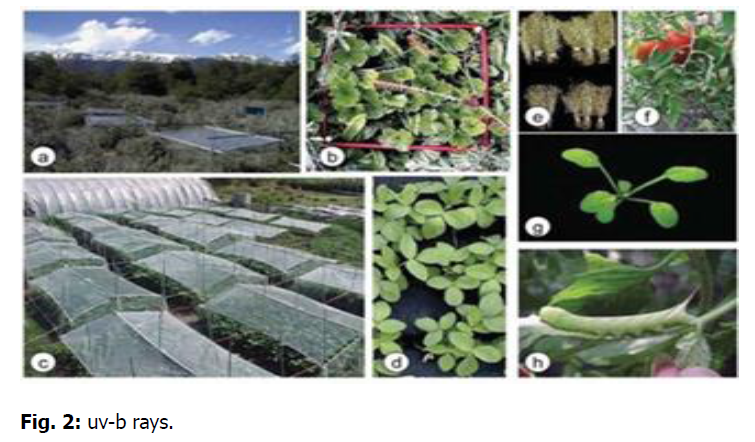Mini Review - (2021) Volume 0, Issue 0
Photosynthetic physiology
M. Tajalifar*Abstract
Photosynthesis is a significant process that leads to primary production in the biosphere. There are 7,000 billion tons of CO2 in the atmosphere, and it produces more than 100 billion tons of photosynthesis annually. Further evidence suggests that strategies to improve photosynthetic traits can increase plant yield. Nitrogen (N), as a macronutrient, plays a vital role in plant growth. However, photosynthesis and the photosynthetic apparatus are conditioned by environmental variables such as water availability, temperature, [CO2], salinity, and ozone. The omics revolution has made it possible to understand better the genetic mechanisms that regulate stress responses, including the identification of genes and proteins involved in the regulation, adaptation, and adaptation of processes that affect photosynthesis. Various research findings show that UV-B radiation causes changes in plant biological processes, such as damage to the internal structure of photosynthesis or control of its cellular process. Many studies have reported a relationship between photosynthesis and nitrogen supply (N). Here, the physiological response of photosynthesis to N deficiency in leaf structure and N allocation in leaves is summarized.
Keywords
Photosynthesis, biological process, genetic mechanisms, research findings.
Introduction
Photosynthesis is a complex process that can be simplified to optical reactions by electrons through various protein complexes associated with the chloroplast thylakoid membrane and Calvin cycle reactions of CO2 stabilization photosynthesis in the dividing chloroplast stroma. Photosynthesis is a complex process of redox reaction that occurs when the light-absorbing complex absorbs photonic energy and transmits it to the reaction centers of the photosystem. Photosynthesis is the basis of human existence. Extensive mechanical understanding of this process over the years, from morphology and anatomy to biochemistry to molecular biology to biophysics and electrophysiology, makes photosynthesis intuitively an attractive and acceptable way to increase plant productivity. A relatively deep understanding of photosynthesis drives our efforts to manipulate it to increase productivity. The "Photosynthesis Modeling" section is to calculate the increase in carbon for biomass. Finally, the section "Metabolic engineering to improve photosynthesis and adaptation to high carbon dioxide". In light, the photosynthetic electron transfer chain consisting of photosystem II (PSII), cytochrome b6f (cytb6f) complex, photosystem I (PSI), and the free-electron carriers plastoquinone (PQ) and plastocyanin produce ATP and NADPH that enter the Calvin-Benson cycle. (CBC) and other fuel absorption processes.
The advent of omics technologies, such as genomics, transcription, proteomics, metabolomics, ionomics, and hormones, has made it possible to identify photosynthesis-related components, including molecular regulatory circuits, photosynthetic apparatus, and function protective mechanisms. High temperature affects photosynthesis by reducing the oxidation property of PSII receptors and reduces the photosynthetic electron transfer efficiency of both the PSII photosynthetic system and the PSI photosystem. Crop production results from biomass accumulation that depends on photosynthesis, leaf area, and green leaf lifespan, so, in principle, increasing photosynthesis at the single leaf level increases biomass accumulation. There are three significant and interconnected research pathways to increase productivity for future scenarios: phenotype-based, genotype-based, and physiological process-based. Historically, the phenotype-based pathway has been the classical approach to plant breeding and agriculture, and at the same time, the genotype-based pathway includes all molecular approaches, including various "omics" methods for describing genotypes. However, the physiological process-based pathway is a modern molecular physiology approach. Significant advances in biochemical and biophysical aspects underlying photosynthesis were made in the 1960s. Rubisco carboxylase/oxidase functions were identified in the next decade, and Rubisco 3-D structures and Cyt b mutations were present in the late 1980s and 1990s. CO2 has a positive effect on the increase in yield, and it can also be concluded that the change in the amount of nitrogen does not affect the yield. However, the significant variation in the positive effect of increased CO2 on yield depends on the amount of water and nitrogen available.
Complete photosynthesis involves the reaction of light and the reaction of reducing carbon. The optical reaction takes place in the thylakoid chloroplast membrane and consists of three parts: light absorption, electron transfer, and photophosphorylation. Light is absorbed by pigments (mainly chlorophyll) in photosystem (PSI) I and photosystem (PSII) II. The light energy is then converted to electron energy at PSI and PSII and then to NADPH and ATP, which are used in the carbon reduction reaction. This reaction in plants is catalyzed by the four main sets of protein, PSI, PSII, cytochrome complex (Cyt b6f) b6f, and adenosine triphosphate (ATP) synthase. Since CO2 is fixed to C3 or C4 acid, photosynthesis is divided into photosynthesis C3 and photosynthesis C4 (Figs. 1, 2).

Figure 1: Photosynthetic structure.

Figure 2: uv-b rays.
Typically, chlorophyll fluorescence is used to study all stages of photosynthesis in plants. Much research has been done on chlorophyll fluorescence and its role in providing information on the process of photosynthesis in plants. UV-B radiation is absorbed by large molecules such as nucleic acids, proteins, and lipids. Therefore, damaging the internal structure of photosynthesis or controlling their cellular process can alter the biological process of plants. Several studies have shown that a decrease in stomatal conductance in response to UV-B radiation and a decrease in stomatal conductance lead to CO2 restriction in many products. 5. Bisphosphate affects carboxylase/oxygenase.
Conclusion
Our world is rapidly industrializing, and as a result of the release of toxic chemicals into the atmosphere, the ozone layer of the stratosphere is depleted. As a result, the absorption of ultraviolet light by the earth increases, reducing the photosynthetic capacity of plants by directly damaging the structures and processes of photosynthesis. In addition, other stresses such as high-temperature stresses and drought integrate photosynthesis capacity. Today, these stresses reduce photosynthesis and the overall production and productivity of products. Photosynthesis is a complex process that can be simplified to optical reactions by electrons through various protein complexes associated with the chloroplast thylakoid membrane and Calvin cycle reactions of CO2 stabilization photosynthesis in the dividing chloroplast stroma. High temperature affects photosynthesis by reducing the oxidation properties of PSII receptors and reduces the photosynthetic electron transfer efficiency of both the PSII photosynthetic system and the PSI photosystem. CO2 has a positive effect on the increase in yield, and it can also be concluded that the change in the amount of nitrogen does not affect the yield. However, the significant variation in the positive effect of increasing CO2 on yield depends on the amount of water and nitrogen available.
References
www.academic.oup.com/jxb/article
www.frontiersin.org/articles
www.sciencedirect.com/science/article
www.tandfonline.com/doi/full
Author Info
M. Tajalifar*Citation: Tajalifar, M. (2021). Photosynthetic physiology. Ukrainian Journal of Ecology, 11 (6), 82-84.
Received: 21-Jul-2021 Accepted: 02-Aug-2021 Published: 23-Aug-2021
Copyright: This is an open access article distributed under the terms of the Creative Commons Attribution License, which permits unrestricted use, distribution, and reproduction in any medium, provided the original work is properly cited.
